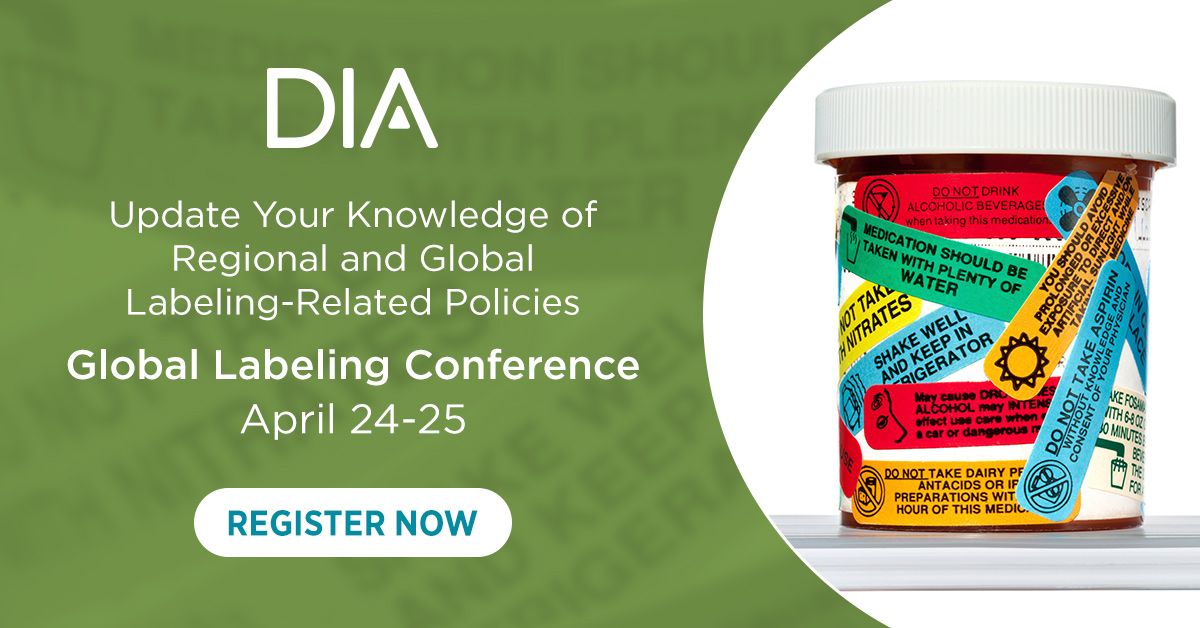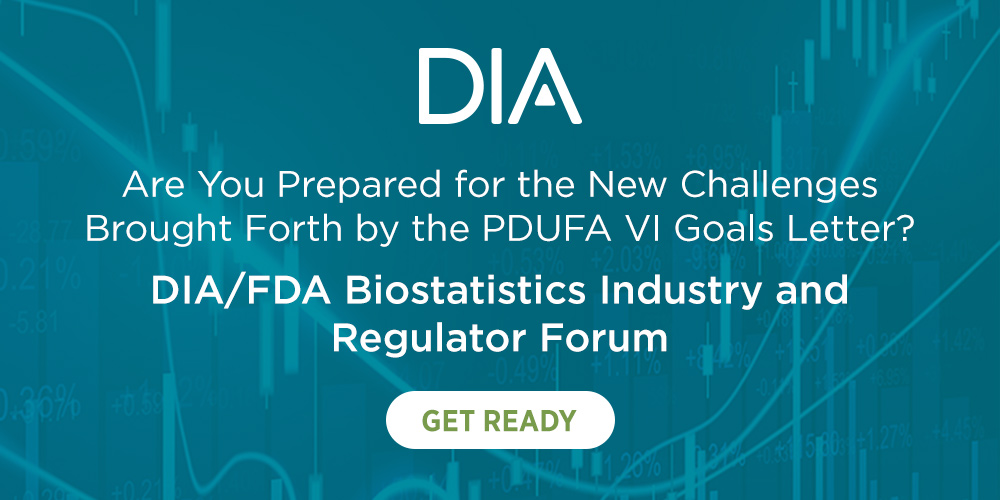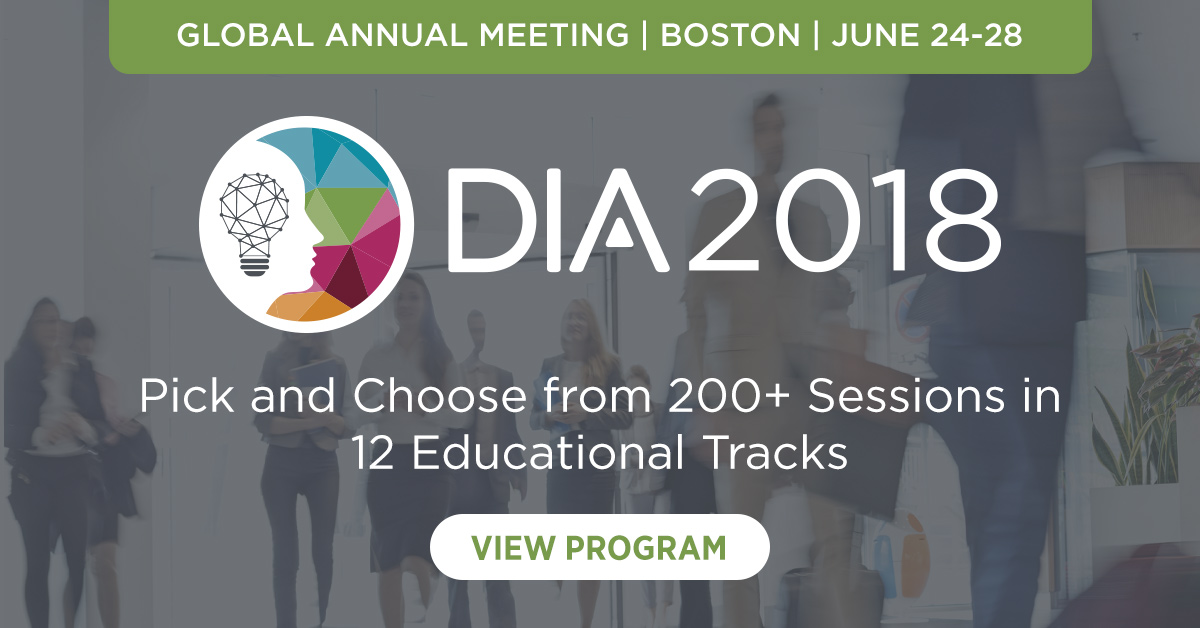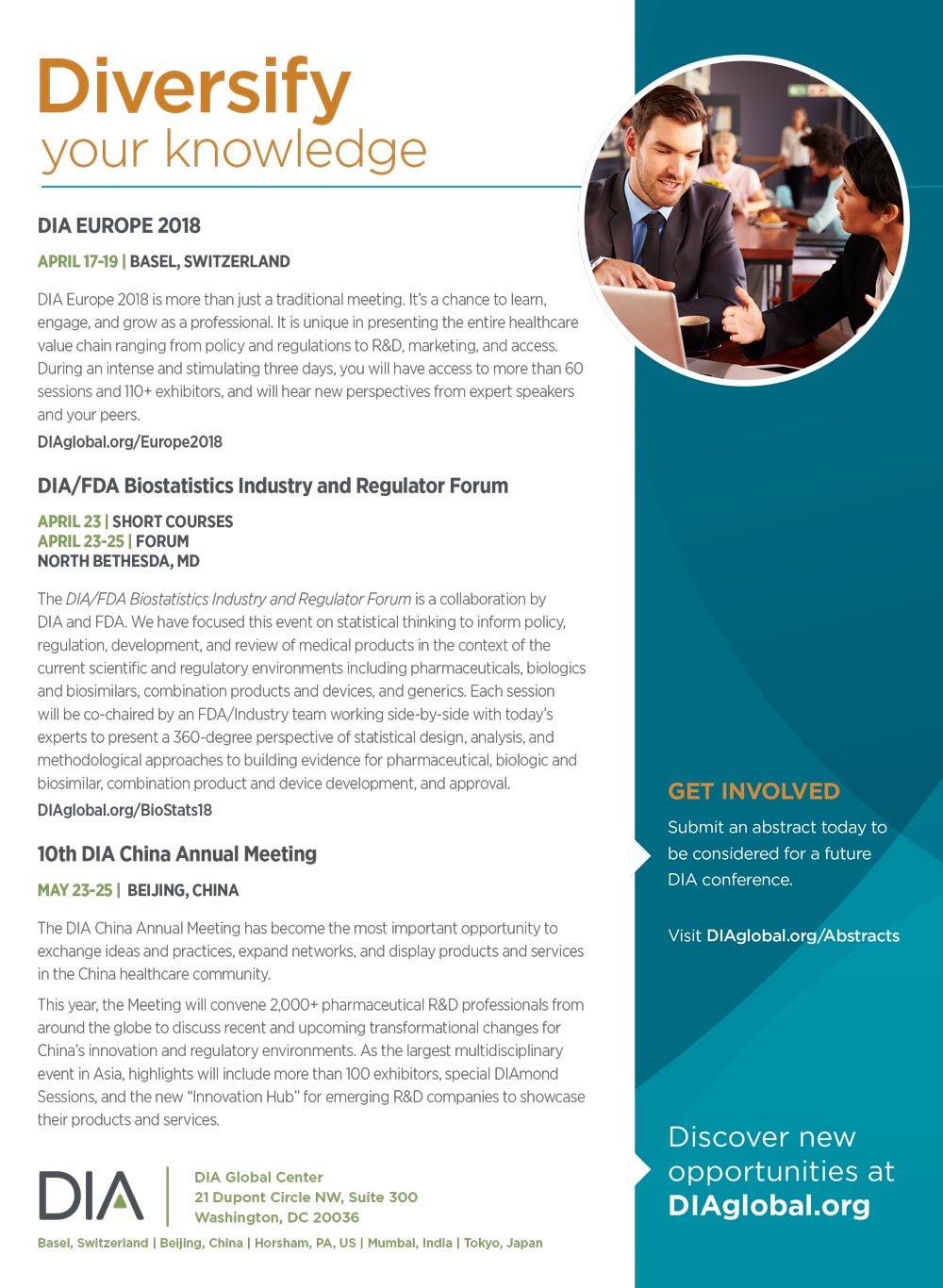April 2018 Global Forum
Table of Contents
From Drug Development to Approval
Highlights from a Panel Discussion
Clinical Trials to Get the Right Drugs to the Right Patients
DIA EUROPE 2018
Around the Globe
2017 CFDA Metrics
Q&A with the Principal Scientific Officer, Indian Pharmacopoeia Commission
Regional Initiatives Gain Momentum in 2018
Japan’s 1st DIA Medical Communication Workshop
Executive Leadership
Driving Momentum
Stepping Up The Pace of Change
Career Column
Community Spotlight
The DIA Study Endpoints Community
Subscribe
Love Global Forum‘s new online format? Subscribe today and never miss an issue.
Executive Leadership | DIA Leadership Message
To Our Readers
Driving Momentum
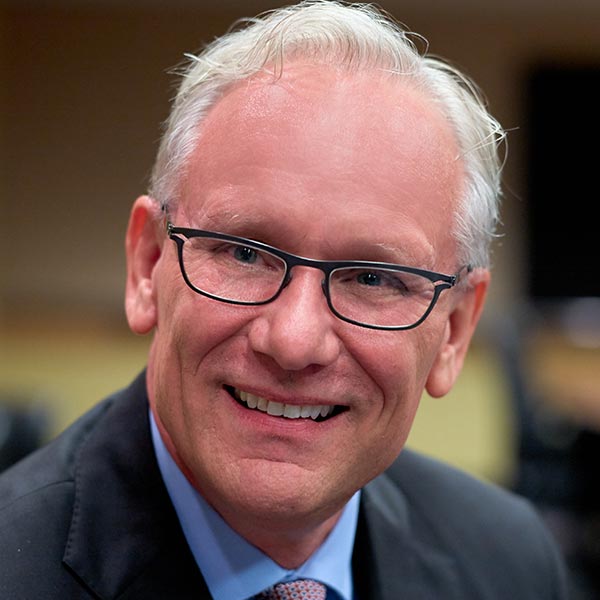
John A. Roberts
Chair, DIA Board of Directors

Barbara Lopez Kunz
Global Chief Executive, DIA
his month, our attention turns toward Basel, Switzerland, where we will gather for our annual DIA Europe 2018 meeting.
We took our first steps into patient engagement at this premier European event nearly two decades ago. Fast forward to 2018 and DIA Europe is a proud, “Patients Included” accredited conference, boasting the highest number of participating voices in nearly a decade!
We put patients and patient outcomes front and center as we explore synergies between HTAs and regulators, outcomes-driven health systems, artificial intelligence in healthcare, and more, without shying away from difficult and controversial questions, such as: Why can’t society determine the healthcare and treatments they want access to, and the price they’re willing to pay for them? Bring your own questions with you as we learn, network, and drive insights to action alongside representatives from global regulatory agencies, academia, industry, associations, the ICH, the World Health Organization, Heads of Medicines Agencies, and many other global stakeholders.
Executive Leadership | Editor’s Message
To Our Readers
Stepping Up The Pace of Change
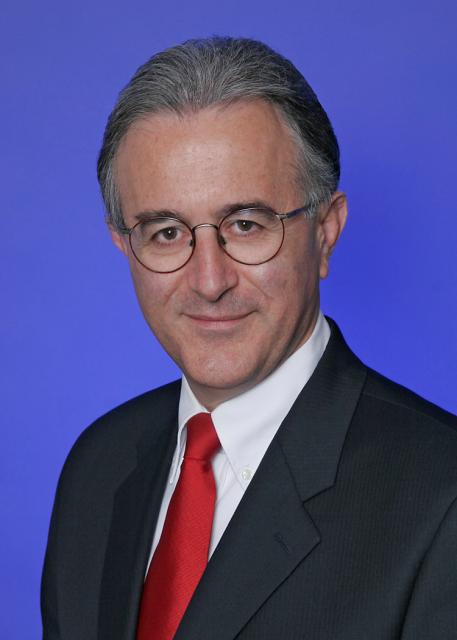
Alberto Grignolo
Editor
Fellow of DIA
r. Paul Janssen, founder and leading light of Janssen Pharmaceuticals until he passed away in 2003, often said, “There is so much more to be done; the patients are waiting.”
This was true then and it holds true now – except that more is being done faster, and some of it is happening in unexpected places.
As we show in this issue of Global Forum, platform trials and enrichment trials are pointing the way to faster drug development and the delivery of the right drug to the right patients. China is working to reduce the “drug lag” and to implement Health Technology Assessment (HTA) to pave a rational way to medicines pricing and reimbursement. Harmonization initiatives are underway in Africa. Pharmacovigilance is leveraging new technology tools and machine learning to improve patient safety reporting. Sri Lanka (a non-small country of 22 million people) is setting up a drug regulatory framework to serve its patients better, in alignment with global standards.
Editorial Board
Content stream editors
Translational science
Gary Kelloff US National Institutes of Health
David Parkinson ESSA Pharma, Inc.
regulatory science
Yoshiaki Uyama Pharmaceuticals and Medical Devices Agency (PMDA)
Adora Ndu BioMarin Pharmaceutical, Inc.
Patient engagement
Deborah Collyar Patient Advocates In Research (PAIR)
Lode Dewulf Servier
Value & access
Edith Frénoy European Federation of Pharmaceutical Industries and Associations (EFPIA)
Sean Tunis Center for Medical Technology Policy (CMTP)
Editorial Staff
Alberto Grignolo, Editor PAREXEL International
Ranjini Prithviraj, Senior Managing Editor, Associate Director DIA Publications
Sandra Blumenrath, Science Writer DIA Publications
Chris M. Slawecki, Senior Digital Copyeditor DIA Publications
Regional Editors
AFRICA
David Mukanga Bill and Melinda Gates Foundation
ASEAN
Silke Vogel Duke-National University of Singapore Graduate Medical School
AUSTRALIA/NEW ZEALAND
Richard Day University of New South Wales, Medicine, St Vincent’s Hospital
CANADA
Judith Glennie JL Glennie Consulting, Inc.
Megan Bettle Health Canada
CENTRAL AND SOUTH AMERICA
Jaime Oliveira Bayer S/A
CHINA
Ling Su Shenyang Pharmaceutical University, Lilly Asia Ventures
EUROPE
John Lisman Lisman Legal Life Sciences
INDIA
J. Vijay Venkatraman Oviya MedSafe
JAPAN
Junichi Nishino Global Forum Japan Regional Editor
US
Ann Meeker-O’Connell Johnson & Johnson Quality and Compliance
DIA Membership
Bringing together stakeholders for the betterment of global health care.
The Challenge of Rare Diseases – From Drug Development to Approval
Jonathan Goldsmith
Associate Director (Retired),
Rare Diseases Program,
US Food and Drug Administration
Lucas Kempf
Associate Director (Acting),
Rare Diseases Program,
US Food and Drug Administration
Sandra Blumenrath
DIA Science Writer
espite the approximately 7,000 rare diseases that affect millions of people worldwide, there are comparatively few treatments on the market. In addition to the issues pertaining to small markets, drug development for rare diseases poses unique scientific and ethical challenges.
The patient population affected by rare diseases is typically small, heterogeneous, and widely dispersed, complicating study enrollment, design, and replication. In many countries, there are few specialized sites that provide treatment and could serve as study sites, leading to difficulty acquiring large amounts of high-quality patient data. Additional difficulties arise from the frequently progressive, life-limiting or -threatening nature of rare diseases and the fact that over 50% of those affected by rare diseases are children. There are special ethical considerations for children participating in rare disease clinical trials that need to be anticipated. These are just some of the impediments slowing down the development and approval of life-saving orphan drugs.
New approaches in orphan drug development may offer valuable solutions to overcome these hurdles, streamlining both clinical trials and approval processes to bring much-needed treatments to the market more quickly. Here, we briefly outline some of these new approaches and how they differ from traditional practices.
Machine Learning in Pharmacovigilance
Highlights from a Panel Discussion
Shaun Comfort
Genentech, A Member of the Roche Group
Elenee Argentinis
IBM Watson Health, Life Sciences Solutions
Jennifer Fine
Genentech, A Member of the Roche Group
Bruce Donzanti
Genentech, A Member of the Roche Group
ike many other healthcare areas, the field of pharmacovigilance (PV) is dealing with ever increasing volumes of data. At a panel discussion during the 2018 DIA Pharmacovigilance and Risk Management Strategies Conference in Washington, DC, members from Genentech/Roche, IBM, the US FDA, and the UK Medicines and Healthcare Products Regulatory Agency (MHRA) discussed practical considerations for applying novel technologies like cognitive computing and machine learning (ML) to support pharmacovigilance.
The panel provided a variety of perspectives ranging from the pharmaceutical industry and regulatory authorities to cognitive IT. Here are some key takeaways:
- Accurately measuring the human “gold standard” performance in common PV tasks is critical, allowing us to set benchmarks for evaluating the effectiveness and accuracy of new technologies.
- A “human-technology partnership” between human PV experts and cognitive technology may simultaneously offer speed, scale, consistency, and data quality improvements, while maintaining human oversight and control at key decision points.
- Thoughtfully training cognitive and AI solutions like ML is critical to their performance. Companies will need to apply their best “business knowledge experts” to reviewing and identifying training data that are representative, diverse, consistent, accurate, and complete.
- Both FDA and MHRA expressed interest in exploring use of these technologies in PV, recognizing that they are actively explored by industry.
- To demonstrate compliance, new technologies will need to fit within current regulatory and legal frameworks and be equipped with robust quality systems. For audits and inspections, industry will need to be transparent about how such systems are trained and their performance is evaluated.
- The panel recognized that the great potential of ML and cognitive computing in PV might best be achieved in partnership with the pharmaceutical industry, IT, and regulatory authorities.
Read more to review the current state of PV and the major themes discussed during the session.
![]() Podcasts
Podcasts
US Generic Drug Policy: Less Cost, Same Impact
Maryll Toufanian, JD, Acting Director, US FDA Office of Generic Drug Policy, discusses the US FDA’s Drug Competition Action Plan, why US consumers can feel safe taking generic drugs, and how generic drugs can help reduce costs for healthcare patients and systems. Learn more at our Complex Drug-Device Generic Combination Products conference
Accelerating the Pace of Change: Getting the Right Drugs To the Right Patients
Helen Diller Family
Comprehensive Cancer Center,
University of California San Francisco
Helen Diller Family
Comprehensive Cancer Center,
University of California San Francisco
he following article describing the I-SPY2 trial summarizes this multi-year effort and its important research achievements regarding increased efficiency in evaluating and developing promising therapeutic drugs for, as well as improvement in strategies for treatment and care of, individual breast cancer patients. These drug development advances derive from using an efficient master protocol and a platform (umbrella) trial design.
The former involves submission and approval of a protocol which specifies the trial design but allows drug candidates to be subsequently included in a multi-arm trial design when appropriate mechanism of action, dosing, and toxicology data from specific drug candidates become available. It fills the “niche” needed to evaluate breast cancer drug intervention strategies between late recurrence localized disease (not needing chemotherapy) and metastatic disease, focusing on breast cancer populations at risk for early recurrence.
Leaders of Tomorrow at DIA Europe 2018
Chris Slawecki
DIA Senior Digital Copyeditor
ne of the most engaging new components of DIA Europe 2018 is the Leaders of Tomorrow program, which connects emerging pharmaceutical professionals through a mobile app that creates a digital community for sharing their own ideas about healthcare before, during, and after they convene in Basel for DIA Europe 2018, and as they prepare for our DIA Global 2018 gathering in Boston later this year.
Recognizing that digital – or, more specifically, mobile – engagement is the primary way in which these leaders learn and work, DIA Marketing Manager Julien Meinrad and Elena Popa, who lead the DIA team behind this new initiative, strategized the Leaders of Tomorrow (LoT) program to neatly fit within their connected world. LoT aims to bring together emerging professionals with similar profiles; topic channels in the app encourage their conversations in regulatory science, clinical science, pharmacovigilance, or other interest areas. At press time, there were nearly 500 users; 620 posts; 4,800 comments; 8,000 likes; and 15,000 views of the newsfeed, in the app.
![]() Podcasts
Podcasts
Will AI Make Workers More (or Less) Valuable?
Patrick Brady, Vice President for Regulatory Policy & Intelligence at Bayer, discusses the impact of artificial intelligence on clinical and regulatory science professionals. Mr. Brady will moderate the panel discussion Exploring the Use of Artificial Intelligence: Trust in Technology, or Trust in Each Other? at DIA Europe 2018.
![]() Podcasts
Podcasts
New EU CTR: One Application, One Portal, One Decision
Harmonizing clinical trial assessment and supervision in the EU through the portal and database established by the new EU Clinical Trial Regulation, and maintained by the EMA, is not the only change rippling through clinical trials in Europe, explain Dr. Mireille Muller, Regulatory Policy Director for Novartis A-G in Switzerland; and Dr. Greet Musch, Director-General for Pre-Authorisation at the Federal Agency for Medicines and Healthcare Products of Belgium. Dr. Muller and Dr. Musch will help lead discussions on this topic at DIA Europe 2018.
![]() Podcasts
Podcasts
Can Europe Optimize Healthcare Quality AND Pricing?
Processes to better determine a medicine’s value are discussed by Dr. Indranil Bagchi, Vice President, Value and Access, Novartis Oncology, and Dr. Thomas Szucs, Professor of Pharmaceutical Medicine and Director of the European Center of Pharmaceutical Medicine at the University of Basel, who will help lead discussions on value and access at DIA Europe 2018.
![]() Podcasts
Podcasts
Need for Value Creates Opportunity for Patients
Today’s patients can get involved at either end of the “bench to bedside” cycle, explain Christopher McCabe, Executive Director and CEO, Institute of Health Economics (Canada), and Dimitrios Athanasiou, board member of United Parent Projects Muscular Dystrophy and patient representative to EURORDIS, who will also help guide patient engagement discussions at DIA Europe 2018.
Around The Globe
Reducing the China “Drug Lag”: 2017 CFDA Metrics
Ling Su
Global Forum
China Regional Editor
he regulatory reform over the last two years has started to produce significant outcomes. According to analyses conducted by GBI Health, in 2017 the China Food and Drug Administration (CFDA) approved a record number of imported new drugs (new chemical entities), and the number of innovative new drug regulatory applications, including clinical trial applications and marketing applications, was also the highest in five years.
The CFDA approved 34 imported innovative chemical drugs and five imported novel biologic products in 2017 (Table). Top three therapeutic areas were oncology, Type 2 diabetes, and hepatitis C. Among the 39 approvals, 24 (or 62%) were granted “priority review” status under the regulator reform initiative.
Around The Globe
Pharmacovigilance Programme of India (PvPI)
Q&A with the Principal Scientific Officer, Indian Pharmacopoeia Commission
n September 2017, the Secretary, Ministry of Health and Family Welfare, Government of India, released the Pharmacovigilance Guidance Document for Marketing Authorization Holders of Pharmaceutical Products in India. This Guidance, which aims to assist these Holders in establishing compliant pharmacovigilance organizations, became effective in January 2018.
In the following Q&A, Dr. Vivekanandan Kalaiselvan, who serves as Principal Scientific Officer at the Indian Pharmacopoeia Commission, explains the Pharmacovigilance Programme of India (PvPI) and his role in it.
![]() Podcasts
Podcasts
PvPI: Technology Meets Opportunity to Improve Safety
Dr. J. Vijay Venkatraman, India Regional Editor for Global Forum and Managing Director & CEO for Oviya MedSafe Private Limited (India), discusses the Pharmacovigilance Guidance Document for Marketing Authorization Holders of Pharmaceutical Products in India, which came into effect January 2018, and the Pharmacovigilance Programme of India (PvPI).
Around The Globe
Small but Growing: Drug Development and Regulations in Sri Lanka Benefit Patients
Arjuna Pathmaperuma
Head of Pharmaceutical Review Group,
National Medicines Regulatory Authority, Sri Lanka
ri Lanka, a deceptively small country of 22 million people, has an impressive record of health indicators complemented by a high literacy rate. However, its pharmaceutical sector had been lagging behind.
The country has about 15 drug manufacturers including one multinational company. About 90% of its medicines are imported, mainly from India. University education in pharmacy was established only in the early 1990’s, and the annual output of pharmacy graduates is currently around 140.
Since gaining independence from the British in 1948, Sri Lanka has implemented important periodic changes in drug policies. In 1958, selection of drugs for the government sector based on an essential drug concept was initiated. From 1971 to 1977, as a closed economy, the State became the sole importer of medicines. When the economy was liberalized in 1977, numerous pharmaceutical products began to flood the market. The government realized the need for regulations, which resulted in the enactment of the Cosmetics Devices and Drugs Act of 1980. The head of the Department of Health was designated as the Authority. Yet, there was no marketing authorization procedure for medicines until 1984.
Around The Globe
Africa on the Move:
Regional Initiatives Gain Momentum in 2018
David Makunga
Global Forum
Africa Regional Editor
he new year is only three months old, yet several African regions are progressing rapidly and making plans to advance a number of initiatives in regulatory harmonization and standards setting.
Prominent among them are various regional procedures for joint assessment of sponsor applications – an effort to streamline the assessments while leveraging and sharing scarce resources: the East African Community (EAC) Medicines Regulatory Harmonization (MRH) Initiative, the Economic Community of West African States (ECOWAS), the Southern Africa Development Community (SADC), and the Africa Vaccine Regulatory Forum (AVAREF).
Around The Globe
The CTD as a Medical Communication Tool
Japan’s 1st DIA Medical Communication Workshop
Keiko Tsumori, Author
Leader of the Medical Communication Community, Japan
Junichi Nishino, Editor
Global Forum
Japan Regional Editor
ccording to a survey sent out to the medical writing departments of 24 pharmaceutical companies Common Technical Documents (CTDs), Risk Management Plans (RMPs), and Package Inserts (PIs), are often prepared separately by different departments.
In December 2017, 90 representatives from industry, regulatory authorities, and healthcare providers attended the 1st DIA Medical Communication Workshop in Tokyo, to discuss current issues related to the role of the CTDs in medical communications and share ideas for ideal medical communication in the future, including the importance of considering RMPs and PI during preparation of CTDs (Module 2 to Module 5) from the beginning.
Why it matters: As patient centricity expands and the volume of available product information continues to grow, it is critical to provide consistent and accurate information on healthcare products.
Career Column
Filling the Jar: Lesson in Time Management
Post-Doctoral Fellow, AstraZeneca
magine a glass jar, with its empty space representing all of the time in our life. Just as there are 24 hours in a day or 365 days in a year, the volume inside this jar is finite.
First, place four to five large rocks in the jar. These represent the major time commitments in our lives: family, health, careers, major work projects, and (often most overlooked) sleep. Accordingly, these rocks take up the majority of space in the jar.
Next, pour a handful of pebbles into the jar. Imagine them filling in the spaces between the larger rocks. These pebbles represent other time commitments that are relatively less important than the large rocks. Depending on the individual, these pebbles represent things like catching up with friends, brunch, hobbies, exercising, and/or volunteering. At this point, the jar looks quite full. Between the rocks and the pebbles, there is considerably less empty space in the jar.
Community Spotlight
What to Measure, How to Measure It:
The DIA Study Endpoints Community
Senior Director, Oxford Outcomes,
An ICON plc Company
Head of Patient Reported
Outcomes, Sanofi
he DIA Study Endpoints (SE) Community is a forum for healthcare professionals involved in the selection, development, analysis or interpretation of study endpoints, to come together and share knowledge, with the ultimate aim of advancing the scientific development and evaluation of study endpoints for healthcare interventions.
Who Are We?
The SE Community includes over 200 members from various backgrounds across the pharmaceutical/biotech, medical device, CRO, regulatory, and consulting fields. The Community is co-chaired by Matthew Reaney and Emuella Flood and includes Keith Wenzel (Communications and Education Series), RJ Wirth (Education Series) and Bryan Bennett (Education Series) as part of its core team.
Listen & Learn
Have You Heard? DIA Podcasts
DIA podcasts offer listeners a unique opportunity to hear from leaders in healthcare product development, regulation, and patient advocacy. Subscribe to our Driving Insights to Action Podbean podcast channel to stay connected!

Thanks for reading our April 2018 Issue!



